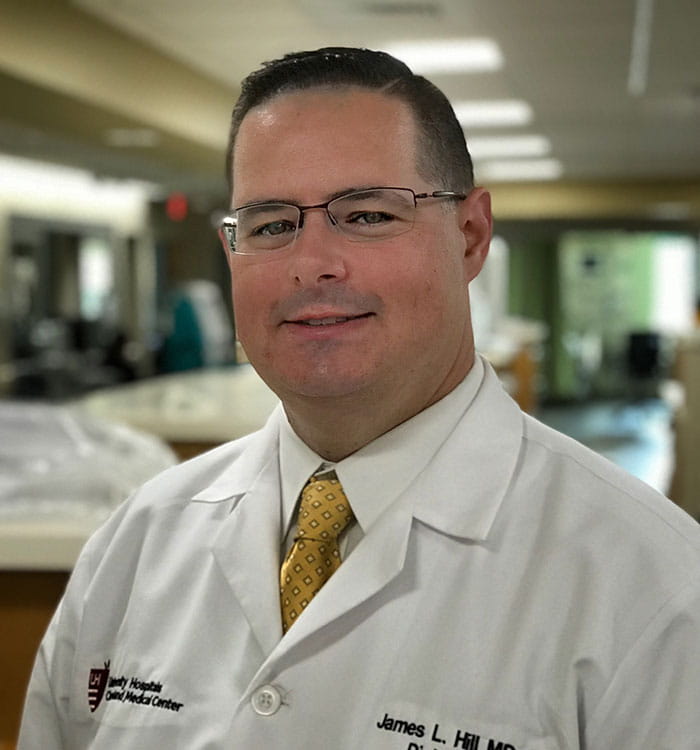UH Develops First-of-Its-Kind Transfusion Management Software
June 23, 2019
Transfusion appropriateness algorithm powering the tool was created using recommended transfusion criteria supported by a multidisciplinary team of more than 30 UH experts
UH Clinical Update | June 2019
It is recognized that nearly 50 percent of all blood transfusions are not clinically necessary.

“There’s no doubt that transfusions save lives, especially in trauma patients,” says James Hill, MD, a critical care and anesthesiology specialist at UH and System Medical Director for Transfusion Services and Blood Management. “But there can be harms that come from a transfusion – allergic reactions, anaphylaxis, fever, transfusion-related lung injury. But then there’s a whole host of things that are underneath the surface that we don’t traditionally think of as sequelae to transfusion, such as MI, renal failure, transfusion-related immune modulation. When you start giving blood that isn’t indicated, you’re raising the patient’s risk.”
The trouble also comes in gauging whether all the transfusions given across a large system like UH are appropriate. Off-the-shelf software programs exist, but they simply give a yes or no answer based on established guidelines for red blood cells, platelets, plasma and cryoprecipitate. Absent from these programs are any exceptions particular to different specialties or the ability to generate data for individual providers making transfusion decisions.
Enter the UH Blood Management Program. Launched as a high-reliability medicine initiative in 2016, the program and its team members have spent the last two years gathering and coding data on UH transfusions from the various EMR platforms and the blood bank management software HCLL. Importantly, they’ve also involved more than 30 specialists from across the system to review evidence and make recommendations to develop an appropriateness algorithm for giving blood products, through which this data can be fed.
“We started with 90 clinical points in the care of patients that would affect their stability and need for blood,” says Jennifer Dawson, Senior Operations Engineer on the project. “From there, we took 30 different specialists – chiefs and chairs and other specialists – and asked them, ‘What in your practice makes these four industry standards not the right measures for you?’ Each of the specialists went into the literature and came back to the team with data or shared with the team their experience and expertise and those of their peers. In the end, the goal was to agree to a set of standards for measuring themselves and their departments.”
Although a 25 percent reduction in the use of red blood cells and platelets has been seen at UH Cleveland Medical Center, the data run through the transfusion appropriateness algorithm indicate a 25 percent opportunity for more judicious transfusion practices in 2019. Data from UH Ahuja and UH Parma medical centers is currently being validated; other community hospitals will come on line with the project later this fall.
Data will be available by hospital, service line/department and individual provider. In fact, more than 350 providers at UH Cleveland Medical Center have already received PDF dashboards, featuring transfusion practices for each of the four blood products. Ultimately, these software dashboards will be interactive, allowing the provider to drill down to the details of individual patients. This blood management dashboard will also be included in each provider’s suite of quality metrics by which they are evaluated.
Dr. Hill and Dawson are currently talking with different departments about their metrics and changes in practice that may be necessary.
“We’re not prescribing how the department will approach it,” Dawson says. “We’re working collaboratively with them to make plans to influence clinical practice.”
“Each CMO at each hospital should embrace this and find a physician lead to serve as champion,” adds Dr. Hill. “We’ll provide that person with educational materials and support to help spread this program across the system.”
The initial phase of the Blood Management Program at UH was funded by grants from the Ohio University Technology Validation & Startup Fund and the National Institute of Health Center for Accelerated Innovations, with matching funds from UH Ventures. Ultimately, the goal is to create a viable commercial product to fill the unmet clinical need.
“The Transfusion Management Software has significant commercial potential by improving the quality of care while driving a reduction in cost,” says Neil Wyant, Managing Director of UH Ventures. “It is a great example of the kinds of projects UH Ventures supports through our Technology Validation Start-up Fund, and also representative of how we help to identify and assemble additional resources to support UH innovators, in this case via funding from the NIH Centers for Accelerated Innovations.”
“By creating a software system that is more accurate for UH’s needs, it paves the way for possible commercialization later on,” Dr. Hill adds.
If you are interested in reviewing your own transfusion data, please contact Jennifer.Dawson@UHhospitals.org.
Tags: Medical Innovations


